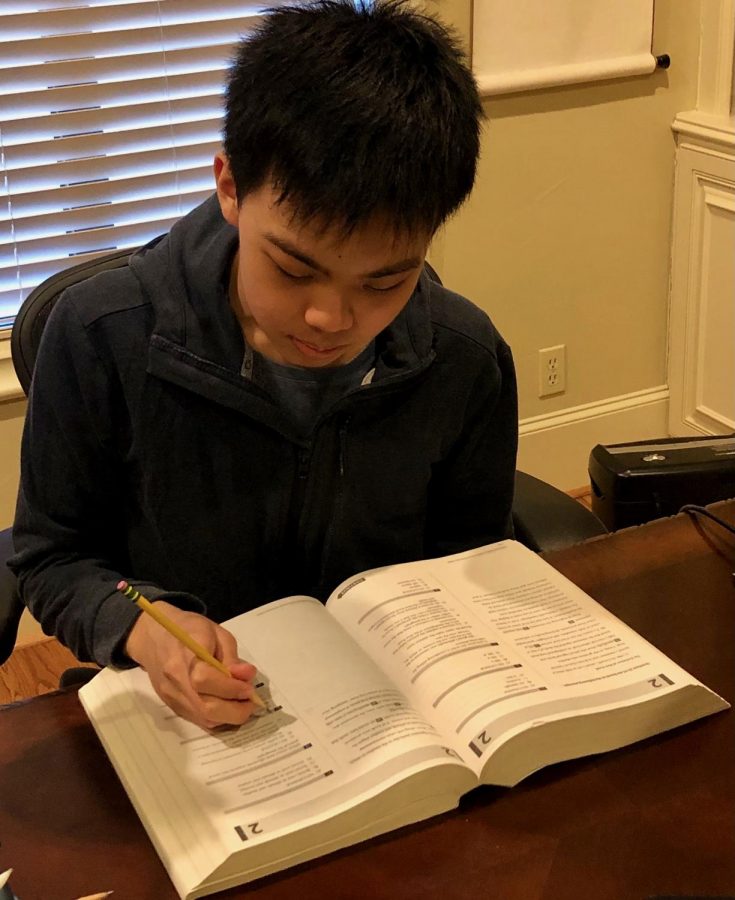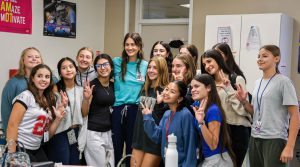PSAT sign-up deadline March 4; students choose not to take test due to health concerns
Photo provided by Christopher Ho
Christopher Ho uses an SAT book to prepare for the PSAT. To make up for online school giving fewer practice opportunities, he took advantage of the recent power outages and got some practice in. “I did a bunch of stuff I would have never found the resolve to do in the past because I would become distracted on YouTube,” said Ho.
Mar 4, 2021
Following school shutdowns the week of Feb. 15 due to the historic Texas freeze, Bellaire administrators received approval from the College Board to move the PSAT 10 to March 10. The deadline to sign up is March 4.
According to Miriam Mulet, assistant principal and testing coordinator, even though the test is free and open to all sophomores, only 200 out of 890 eligible students have signed up so far. In contrast, last year, almost every sophomore tested.
The College Board has not created a way for the PSAT or SAT to be given remotely, so the only option is for students to come to campus for the test. This has prevented some potential test-takers from attending.
Sophomore Cassie Wills said her decision to opt-out of the PSAT 10 didn’t take much thought.
“Out of the four people in my house, two are high-risk and my mother is a teacher,” Wills said. “So if I can stay home, I might as well not contribute to anything COVID-19 related. The sophomore PSAT isn’t as important as the junior one so I’m willing to sacrifice this year’s test.”
According to the Princeton Review, the PSAT/NMSQT, taken by juniors, differs from the PSAT 8/9 and the PSAT 10. In addition to providing SAT practice, it can qualify juniors for National Merit scholarships. As an added bonus, many colleges offer additional scholarships to students who receive high scores on the PSAT/NMSQT.
This fact made junior Thalia Cerda’s decision not to take the PSAT/NMSQT earlier this year harder, but she said she didn’t feel comfortable going to an in-person test.
“We’re still in the middle of the pandemic and they should’ve figured out an alternative option where the students wouldn’t have to come to school and risk exposure to the virus,” Cerda said. “It’s really concerning.”
Mulet said she understands the hesitation of students and families related to in-person tests and supports whatever decision they make.
“The good thing is that the SAT was waived for some colleges,” Mulet said. “This helps students that can’t test on campus.”
Sophomore Christopher Ho said his parents encouraged him to sign up for the PSAT 10 because it would be good practice for the PSAT/NMSQT.
“It’s just not the same to be reviewing at home,” Ho said. “With virtual learning, I’m not used to tests in-person so I want to re-acclimate myself to it. Plus, it will allow me to see what I’m deficient at so I can go back and practice to get my score up in the future.”
Ho admits he doesn’t feel that prepared for the test.
“We’re probably not receiving as many reading passages or math as we normally would in an in-person year,” Ho said.
To make up for the online setting, Ho took advantage of the recent power outages and got some practice in.
“I was pretty bored, so I did a bunch of stuff I would have never found the resolve to do in the past because I would become distracted on YouTube,” Ho said. “So I just got one of the SAT books out and started practicing to see where I needed to review.”
For students without practice books at home, the College Board provides free practice tests on their website to help prepare for the PSAT 10.
Mulet said she and fellow administrators are working to make sure students stay safe during the test and avoid increasing COVID rates. All students have their temperatures checked before they enter the building and they limit the number of students in each testing room.
“In a normal year, we have 30 students test in a classroom,” Mulet said. “In October, for the 11th grade PSAT, I had a max of seven students testing in each classroom.”
Some other precautions include individual pencils and calculators, gloves and wipes provided for teachers and strict mask requirements.
For Wills, there are other disadvantages of virtual school besides just missing out on opportunities.
“I procrastinate a lot more because there’s at-home distractions, people screaming and other classes going on at the same time,” Wills said. “Plus I just want to sleep, staying focused while trying to balance everything at home is tough. It kind of sucks, because people are just meeting up whenever they want to while I’m trying to keep my family safe. I just tell myself it’s hopefully only one year.”







